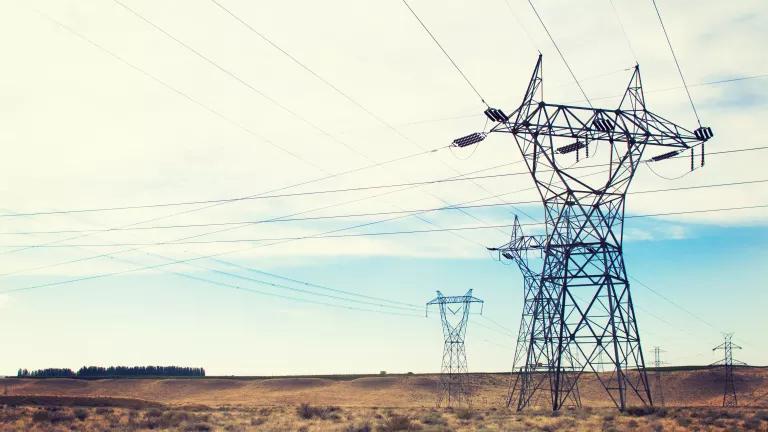
This is the fifth blog in a series about our Midwest electric vehicle adventure.
When you think about electric vehicles (EVs), you might first think of passenger cars for personal or family use. That description fits the fully electric Chevy Bolt we’re driving on our EV road trip. But EVs are also an important part of mass transportation—from public transit options like street cars, light rail, and buses to 21st-century options like electric car shares, app-linked ride hailing services, and microtransit possibilities.
On our tour of the Midwest, we’ve seen that cities across the region are rapidly taking advantage of these innovations.
Electrified transportation supports a suite of options to get people where they need to go. Let’s examine the wide range of mobility-expanding public electrification efforts we’ve seen and heard about on our trip, stop by stop.
Intermodal Route Planning in Columbus
One of the first things we saw while driving in Downtown Columbus was Smart Columbus’s autonomous electric shuttle pilot. To be clear, Smart Columbus is simply exploring how (and if) autonomous public transit options can safely serve their city’s needs. The pilot is just one example of Columbus’s cutting-edge work to integrate the transportation options of the future into public life.
The Smart Columbus Experience Center is all about expanding access to varied transit options. As McKinzie Harper explained, she’s had no problems living downtown and getting around—even after ditching her car.
Indeed, in addition to the electric BMW i2 and Mitsubishi Outlander plug-in hybrid we saw on the Experience Center floor, we tried out a large touch screen that helps plan intermodal trips around Columbus, connecting transit routes to local restaurants, entertainment venues, and more.
Hailing Electric Rides in Cincinnati
Cincinnati residents who might not be looking to buy an EV themselves (although many are) have a variety of other electric transportation options to choose from, all delivered in the last few years. In 2016, the city opened the Cincinnati Bell Connector, a single-rail electric streetcar that follows a 3.6-mile loop and connects major destinations like the Riverfront, Downtown, and Over-the-Rhine.
There’s also electric ride hailing options in the downtown area, like Gest Carts and Oggo. Both are free or very low cost for riders, relying on revenue from advertisers and sponsors. When we met with Oggo’s founders, they emphasized that their goal is to fill the need for an easy-to-use, accessible, last-mile transportation option for the city. Emphasizing the importance of partnerships, they’ve been in dialogue with the city since their inception in 2018.
Buses and BlueCars in Indianapolis
You don’t have to spend much time in Downtown Indianapolis to notice the wide range of electric transportation options that exist: green-topped electric buses; small, curvy cars emblazoned with the turquoise BlueIndy logo; and, to be sure, the electric scooters that have hit so many city streets.
Lately, Indianapolis has been making headlines with its bus fleet plans: the new $96 million, 13-mile Red Line will feature electric buses arriving every 10 minutes and is complete with wireless charging pads to boost driving range. The buses will operate in a dedicated lane to function as a high-frequency rapid transit system. The system will provide a cost-effective means of avoiding street traffic and eliminating air pollution.
BlueIndy’s EVs have become a staple of Downtown Indianapolis. Launched in 2015, BlueIndy is the first electric car share in the U.S. The program is similar to Zipcar: it uses a membership-based card to unlock cars, and participants pay different rates based on how long they take one out for a spin. The biggest difference? You’ve got to plug it back in when you park in a designated BlueIndy spot.
The Indianapolis Office of Sustainability told us we can also look forward to a fleet of electric school buses in the near future—a key step to keep students breathing clean.
The Future of Electric Transportation
We’re excited about the steps that Columbus, Cincinnati, and Indianapolis have taken in expanding transportation electrification in their cities. While the cost of EVs has dropped considerably over the past several years, we still need to strengthen options for individuals who can’t afford a personal car, who don’t want one, or who need alternate methods of transportation due to disabilities. Columbus, Cincinnati, and Indianapolis show how cities can play a leading role in solving the last-mile problem. Cities need to continue exploring and making commitments to the full range of electric transportation options.
We went on a Midwest electric vehicle road trip to talk about transportation policy, highlight the already-booming benefits of electric vehicles to local economies, and shatter stereotypes about what it means to be an electric vehicle driver. We’re blogging about our findings, including tips for other aspiring roadtrippers and policy suggestions for further progress.
Other blogs related to our adventure include:
Driving (on) Clean Energy: Touring the Midwest in an EV
State of the States: EVs and EV Policy in the Midwest
Road Trip Report: How Ohioans Buy EVs (It Should Be Easier)
Avoiding Range Anxiety with an EV Road Trip Checklist
Midwest Electric Vehicles in 5 Maps



